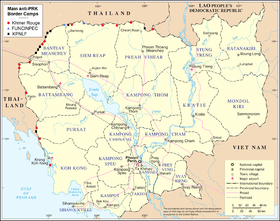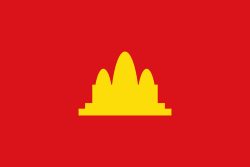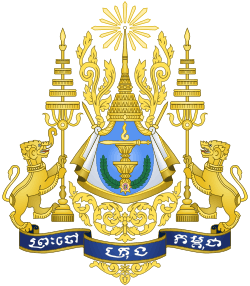Coalition Government of Democratic Kampuchea
The Coalition Government of Democratic Kampuchea (CGDK; Khmer: រដ្ឋាភិបាលចំរុះកម្ពុជាប្រជាធិបតេយ្យ, Odthaphibeal Chamrouh Kampouchea Brachathibtey), renamed to the National Government of Cambodia (NGC; រដ្ឋាភិបាលជាតិនៃកម្ពុជា, Rodthaphibeal Cheate nei Kampouchea) from 1990, was a coalition government in exile composed of three Cambodian political factions, namely Prince Norodom Sihanouk's FUNCINPEC party, the Party of Democratic Kampuchea (PDK; often referred to as the Khmer Rouge) and the Khmer People's National Liberation Front (KPNLF) formed in 1982, broadening the de facto deposed Democratic Kampuchea regime. For most of its existence, it was the internationally recognized government of Cambodia.
Coalition Government of Democratic Kampuchea (1982–90) រដ្ឋាភិបាលចំរុះកម្ពុជាប្រជាធិបតេយ្យ Gouvernement de coalition du Kampuchéa démocratique National Government of Cambodia (1990–93) រដ្ឋាភិបាលជាតិនៃកម្ពុជា Gouvernement national du Cambodge | |||||||||
|---|---|---|---|---|---|---|---|---|---|
| 1982–1992 | |||||||||
 Coat of arms
| |||||||||
.svg.png) Location of Kampuchea, occupied by Vietnam | |||||||||
| Status | Provisional government-in-exile Internationally recognized state | ||||||||
| Capital | De jure Phnom Penh Anlong Veng | ||||||||
| Common languages | Khmer | ||||||||
| Government | Provisional government in exile | ||||||||
| President | |||||||||
• 1982–1987 | Norodom Sihanouk | ||||||||
| Vice President | |||||||||
| Prime Minister | |||||||||
• 1982 | Son Sann | ||||||||
| Historical era | Cold War Cambodian–Vietnamese War | ||||||||
• Formed | 22 June 1982 | ||||||||
• Paris Peace Agreement | 23 October 1991 | ||||||||
• UNTAC mission begins | 15 March 1992 | ||||||||
| Area | |||||||||
| 181,035 km2 (69,898 sq mi) | |||||||||
| Currency | Cambodian riel | ||||||||
| Calling code | 855 | ||||||||
| |||||||||
| Today part of | Cambodia | ||||||||
International recognition
.jpg)
The signing ceremony of the coalition took place in Kuala Lumpur on 22 June 1982.[1] The president of the coalition was Prince Norodom Sihanouk, the prime minister was the KPNLF leader Son Sann and the foreign secretary was PDK leader Khieu Samphan.[2]

The CGDK was allowed to retain the Cambodian/Kampuchean seat in the United Nations on the premise that it was a legitimate Cambodian government in contrast to the pro-Vietnamese People's Republic of Kampuchea regime (the Western states had previously opposed proposals by the Eastern Bloc countries to replace the Khmer Rouge-held seat of Cambodia by the representation of the Vietnamese-installed regime). The United Nations General Assembly voted on the proposed ouster of Democratic Kampuchea: 91 rejected the proposal, there were 29 countries in favour and 26 abstentions. In contrast, the results in 1981 had been 77–37–31.[3] The CGDK was also recognised by North Korea, whose leader, Kim Il-Sung had offered Sihanouk sanctuary with China. During a meeting in Pyongyang between Kim Il-sung and Sihanouk on 10 April 1986, Kim Il-Sung reassured Sihanouk that North Korea would continue to regard him as the legitimate head of state of Cambodia.[4][5]
History
After the Khmer Rouge regime was overthrown, the Chinese leader, Deng Xiaoping, was unhappy[6] with Vietnam's influence over the PRK government. Deng proposed to Sihanouk that he co-operate with the Khmer Rouge to overthrow the PRK government, but the latter rejected it,[7] as he opposed the genocidal policies pursued by the Khmer Rouge while they were in power.[6] In March 1981, Sihanouk established a resistance movement, FUNCINPEC which was complemented by a small resistance army known as Armée Nationale Sihanoukiste (ANS).[8] He appointed In Tam, who had briefly served as Prime Minister in the Khmer Republic, as the commander-in-chief of ANS.[9] The ANS needed military aid from China, and Deng seized the opportunity to sway Sihanouk into collaborating with the Khmer Rouge.[10] Sihanouk reluctantly agreed, and started talks in March 1981 with the Khmer Rouge and the Son Sann-led KPNLF on a unified anti-PRK resistance movement.[11] After several rounds of negotiations mediated by Deng and Singapore's prime minister Lee Kuan Yew,[12] FUNCINPEC, KPNLF, and the Khmer Rouge agreed to form the CGDK in June 1982. The CGDK was headed by Sihanouk, and functioned as a government-in-exile.[13]
Prior to the formation of the CGDK political coalition, in the late 1980s and early 1990s the Sonn Sann and Sihanouk opposition forces, then known as the KPNLF and FUNCINPEC, drew some military and financial support from the United States, which sought to assist these two movements as part of the Reagan Doctrine effort to counter Soviet and Vietnamese involvement in Cambodia. In 1984 and 1985, the Vietnamese army's offensives severely weakened the CGDK troops' positions, in effect eliminating the two non-communist factions as military players, leaving the Khmer Rouge as the sole military force of importance of the CGDK.[14] One of the Reagan Doctrine's principal architects, The Heritage Foundation's Michael Johns, visited with Sonn Sann and Sihanouk forces in Cambodia in 1987 and returned to Washington urging expanded United States support for the KPNLF and the Sihanouk resistance forces as a third alternative to both the Vietnamese-installed and supported Cambodian government and the Khmer Rouge, which also was resisting the government.[15]
Although the PDK was for the most part isolated from diplomacy, their National Army of Democratic Kampuchea were the largest and most effective armed forces of the CGDK. In 1987, Prince Sihanouk proceeded to take a leave of absence from his position as the president of the CGDK, a move that raised the hopes of Hanoi and Moscow that he would depart the coalition.
In 1990, in the run up to the United Nations sponsored Paris Peace Agreement of 1991 the CGDK renamed itself the National Government of Cambodia. It was dissolved in 1993, a year which saw the United Nations Transitional Authority in Cambodia turn power over to the restored Kingdom of Cambodia. In July 1994, the Khmer Rouge would form an internationally unrecognised rival government known as the Provisional Government of National Union and National Salvation of Cambodia.
References
- Carney, Timothy. Kampuchea in 1982: Political and Military Escalation. p. 76
- Carney, Timothy. Kampuchea in 1982: Political and Military Escalation. p. 80. In Asian Survey, 23:1, 1983.
- Daniel Bultmann (2015) 'Inside Cambodian Insurgency. A Sociological Perspective on Civil Wars and Conflict', Ashgate: Burlington, VT/Farnham, UK, ISBN 9781472443076.
- Odd couple: The royal and the Red By Bertil Lintner Archived 21 June 2016 at the Wayback Machine Asia Times online. Accessed on 15 August 2009.
- Jeldres (2005), p. 207.
- Jeldres (2005), pp. 197–98.
- Jeldres (2005), p. 235.
- Mehta (2001), p. 68.
- Osborne (1994), p. 251.
- Jeldres (2005), p. 236.
- Jeldres (2005), p. 239.
- Jeldres (2005), p. 240.
- Explaining ASEAN: Regionalism in Southeast Asia By Shaun Narine. Google Books.
- "Cambodia at a Crossroads," by Michael Johns, The World and I magazine, February 1988.
Further reading
- Jeldres, Julio A (2005). Volume 1 – Shadows Over Angkor: Memoirs of His Majesty King Norodom Sihanouk of Cambodia. Phnom Penh: Monument Books. ISBN 974-92648-6-X.
- Osborne, Milton E (1994). Sihanouk Prince of Light, Prince of Darkness. Honolulu: University of Hawaii Press. ISBN 978-0-8248-1639-1.
- Mehta, Harish C. (2001). Warrior Prince: Norodom Ranariddh, Son of King Sihanouk of Cambodia. Singapore: Graham Brash. ISBN 981-218-086-9.

